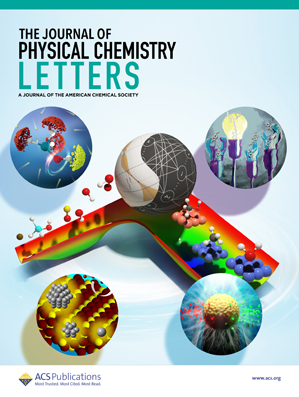非绝热隧穿分裂理论
IF 4.8
2区 化学
Q2 CHEMISTRY, PHYSICAL
引用次数: 0
摘要
估计隧道分裂是量子力学理论方法的一个长期挑战。有时分裂是如此之小,即在一个波数的一小部分内,突破了实验检测和计算精度的极限。目前,大多数计算方法最多只能得到对称或非对称势的基态隧穿分裂。在这封信中,我们介绍了一个统一的理论方法,基于两态近似,可以同样适用于对称和非对称绝热势交叉和激发态,提供可靠的估计,甚至对接近能量交叉的状态。该方法为模型势系统的隧道分裂的解析逼近打开了大门。它为将振动摄动理论引入非绝热隧穿劈裂的估计提供了一个框架。它还提供了对半经典理论的新见解,导致基于瞬时的最陡下降表达式也适用于激发态。模型系统的数值测试是有前景的,为未来多维应用的实现提供了基础。本文章由计算机程序翻译,如有差异,请以英文原文为准。

Theory of Nonadiabatic Tunneling Splitting
Estimating tunneling splittings is a long-standing quantum mechanical challenge for theoretical methods. Sometimes splittings are so small, i.e., within a fraction of a wavenumber, pushing the limits of experimental detection and computational precision. Currently, most computational methods are able, at best, to obtain only ground-state tunneling splittings, either for symmetric or asymmetric potentials. In this Letter, we introduce a unified theoretical approach, based on a two-state approximation that can be equally applied to symmetric and asymmetric diabatic potential crossing and for excited states, providing reliable estimates even for states near the energy crossing. The method opens the door to analytic approximations for the tunneling splitting of model potential systems. It provides a framework for the introduction of vibrational perturbation theory to the estimation of nonadiabatic tunneling splittings. It also provides new insight into the semiclassical theory, leading to an instanton based steepest descent expression applicable also to excited states. Numerical tests on model systems are promising, providing the groundwork for implementation to future multidimensional applications.
求助全文
通过发布文献求助,成功后即可免费获取论文全文。
去求助
来源期刊

The Journal of Physical Chemistry Letters
CHEMISTRY, PHYSICAL-NANOSCIENCE & NANOTECHNOLOGY
CiteScore
9.60
自引率
7.00%
发文量
1519
审稿时长
1.6 months
期刊介绍:
The Journal of Physical Chemistry (JPC) Letters is devoted to reporting new and original experimental and theoretical basic research of interest to physical chemists, biophysical chemists, chemical physicists, physicists, material scientists, and engineers. An important criterion for acceptance is that the paper reports a significant scientific advance and/or physical insight such that rapid publication is essential. Two issues of JPC Letters are published each month.
 求助内容:
求助内容: 应助结果提醒方式:
应助结果提醒方式:


